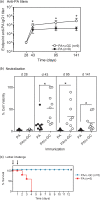CD1d-dependent B-cell help by NK-like T cells leads to enhanced and sustained production of Bacillus anthracis lethal toxin-neutralizing antibodies
- PMID: 20123711
- PMCID: PMC2849421
- DOI: 10.1128/IAI.00002-10
CD1d-dependent B-cell help by NK-like T cells leads to enhanced and sustained production of Bacillus anthracis lethal toxin-neutralizing antibodies
Abstract
The current Bacillus anthracis vaccine consists largely of protective antigen (PA), the protein of anthrax toxin that mediates entry of edema factor (EF) or lethal factor (LF) into cells. PA induces protective antibody (Ab)-mediated immunity against Bacillus anthracis but has limited efficacy and duration. We previously demonstrated that activation of CD1d-restricted natural killer-like T cells (NKT) with a CD1d-binding glycolipid led to enhanced Ab titers specific for foreign antigen (Ag). We therefore tested the hypothesis that activation of NKT cells with the CD1d ligand (alpha-galactosylceramide [alpha-GC]) at the time of immunization improves PA-specific Ab responses. We observed that alpha-GC enhanced PA-specific Ab titers in C57BL/6 mice. In CD1d(-/-) mice deficient in type I and type II NKT cells the anti-PA Ab response was diminished. In Jalpha281(-/-) mice expressing CD1d but lacking type I alpha-GC-reactive NKT cells, alpha-GC did not enhance the Ab response. In vitro neutralization assays were performed and showed that the Ab titers correlated with protection of macrophages against anthrax lethal toxin (LT). The neutralization capacity of the Ab was further tested in lethal challenge studies, which revealed that NKT activation leads to enhanced in vivo protection against LT. Anti-PA Ab titers, neutralization, and protection were then measured over a period of several months, and this revealed that NKT activation leads to a sustained protective Ab response. These results suggest that NKT-activating CD1d ligands could be exploited for the development of improved vaccines for Bacillus anthracis that increase not only neutralizing Ab titers but also the duration of the protection afforded by Ab.
Figures




Similar articles
-
Bacillus anthracis lethal toxin disrupts TCR signaling in CD1d-restricted NKT cells leading to functional anergy.PLoS Pathog. 2009 Sep;5(9):e1000588. doi: 10.1371/journal.ppat.1000588. Epub 2009 Sep 25. PLoS Pathog. 2009. PMID: 19779559 Free PMC article.
-
Neutralizing activity of vaccine-induced antibodies to two Bacillus anthracis toxin components, lethal factor and edema factor.Clin Vaccine Immunol. 2008 Jan;15(1):71-5. doi: 10.1128/CVI.00321-07. Epub 2007 Nov 21. Clin Vaccine Immunol. 2008. PMID: 18032590 Free PMC article.
-
Enhancement of antibody responses to Bacillus anthracis protective antigen domain IV by use of calreticulin as a chimeric molecular adjuvant.Infect Immun. 2008 May;76(5):1952-9. doi: 10.1128/IAI.01722-07. Epub 2008 Feb 19. Infect Immun. 2008. PMID: 18285494 Free PMC article.
-
Anthrax lethal toxin and the induction of CD4 T cell immunity.Toxins (Basel). 2012 Oct;4(10):878-99. doi: 10.3390/toxins4100878. Epub 2012 Oct 19. Toxins (Basel). 2012. PMID: 23162703 Free PMC article. Review.
-
Monoclonal antibody therapies against anthrax.Toxins (Basel). 2011 Aug;3(8):1004-19. doi: 10.3390/toxins3081004. Epub 2011 Aug 15. Toxins (Basel). 2011. PMID: 22069754 Free PMC article. Review.
Cited by
-
Immunization of Mice with Anthrax Protective Antigen Limits Cardiotoxicity but Not Hepatotoxicity Following Lethal Toxin Challenge.Toxins (Basel). 2015 Jun 25;7(7):2371-84. doi: 10.3390/toxins7072371. Toxins (Basel). 2015. PMID: 26120785 Free PMC article.
-
Retinoic acid and α-galactosylceramide differentially regulate B cell activation in vitro and augment antibody production in vivo.Clin Vaccine Immunol. 2011 Jun;18(6):1015-20. doi: 10.1128/CVI.00004-11. Epub 2011 Apr 6. Clin Vaccine Immunol. 2011. PMID: 21471300 Free PMC article.
-
Activation and Regulation of B Cell Responses by Invariant Natural Killer T Cells.Front Immunol. 2018 Jun 18;9:1360. doi: 10.3389/fimmu.2018.01360. eCollection 2018. Front Immunol. 2018. PMID: 29967611 Free PMC article. Review.
-
α-Galactosylceramide-Reactive NKT Cells Increase IgG1 Class Switch against a Clostridioides difficile Polysaccharide Antigen and Enhance Immunity against a Live Pathogen Challenge.Infect Immun. 2021 Oct 15;89(11):e0043821. doi: 10.1128/IAI.00438-21. Epub 2021 Aug 23. Infect Immun. 2021. PMID: 34424751 Free PMC article.
-
Fine tuning a well-oiled machine: Influence of NK1.1 and NKG2D on NKT cell development and function.Int Immunopharmacol. 2013 Oct;17(2):260-6. doi: 10.1016/j.intimp.2013.05.022. Epub 2013 Jun 22. Int Immunopharmacol. 2013. PMID: 23800654 Free PMC article. Review.
References
-
- Barral, P., J. Eckl-Dorna, N. E. Harwood, C. De Santo, M. Salio, P. Illarionov, G. S. Besra, V. Cerundolo, and F. D. Batista. 2008. B cell receptor-mediated uptake of CD1d-restricted antigen augments antibody responses by recruiting invariant NKT cell help in vivo. Proc. Natl. Acad. Sci. U. S. A. 108:8345-8350. - PMC - PubMed
-
- Belperron, A. A., C. M. Dailey, and L. K. Bockenstedt. 2005. Infection-induced marginal zone B cell production of Borrelia hermsii-specific antibody is impaired in the absence of CD1d. J. Immunol. 174:5681-5686. - PubMed
-
- Boyaka, P. N., A. Tafaro, R. Fischer, S. H. Leppla, K. Fujihashi, and J. R. McGhee. 2003. Effective mucosal immunity to anthrax: neutralizing antibodies and Th cell responses following nasal immunization with protective antigen. J. Immunol. 170:5636-5643. - PubMed
-
- Bradley, K. A., J. Mogridge, M. Mourez, R. J. Collier, and J. A. Young. 2001. Identification of the cellular receptor for anthrax toxin. Nature 414:225-229. - PubMed
Publication types
MeSH terms
Substances
LinkOut - more resources
Full Text Sources
Other Literature Sources
Medical
Miscellaneous

